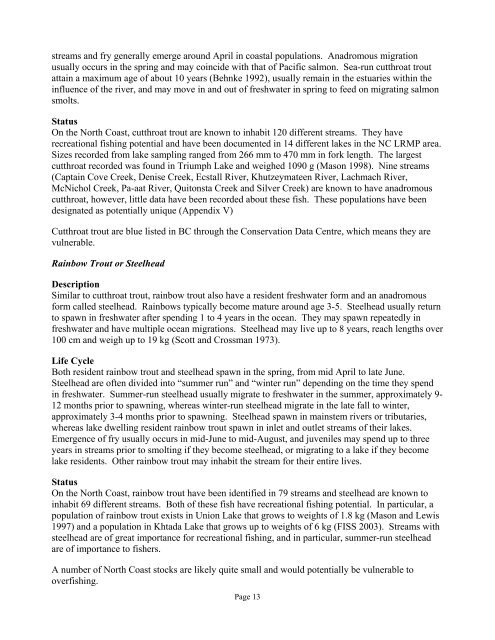Report Template - Ministry of Forests, Lands and Natural Resource ...
Report Template - Ministry of Forests, Lands and Natural Resource ...
Report Template - Ministry of Forests, Lands and Natural Resource ...
Create successful ePaper yourself
Turn your PDF publications into a flip-book with our unique Google optimized e-Paper software.
streams <strong>and</strong> fry generally emerge around April in coastal populations. Anadromous migration<br />
usually occurs in the spring <strong>and</strong> may coincide with that <strong>of</strong> Pacific salmon. Sea-run cutthroat trout<br />
attain a maximum age <strong>of</strong> about 10 years (Behnke 1992), usually remain in the estuaries within the<br />
influence <strong>of</strong> the river, <strong>and</strong> may move in <strong>and</strong> out <strong>of</strong> freshwater in spring to feed on migrating salmon<br />
smolts.<br />
Status<br />
On the North Coast, cutthroat trout are known to inhabit 120 different streams. They have<br />
recreational fishing potential <strong>and</strong> have been documented in 14 different lakes in the NC LRMP area.<br />
Sizes recorded from lake sampling ranged from 266 mm to 470 mm in fork length. The largest<br />
cutthroat recorded was found in Triumph Lake <strong>and</strong> weighed 1090 g (Mason 1998). Nine streams<br />
(Captain Cove Creek, Denise Creek, Ecstall River, Khutzeymateen River, Lachmach River,<br />
McNichol Creek, Pa-aat River, Quitonsta Creek <strong>and</strong> Silver Creek) are known to have anadromous<br />
cutthroat, however, little data have been recorded about these fish. These populations have been<br />
designated as potentially unique (Appendix V)<br />
Cutthroat trout are blue listed in BC through the Conservation Data Centre, which means they are<br />
vulnerable.<br />
Rainbow Trout or Steelhead<br />
Description<br />
Similar to cutthroat trout, rainbow trout also have a resident freshwater form <strong>and</strong> an anadromous<br />
form called steelhead. Rainbows typically become mature around age 3-5. Steelhead usually return<br />
to spawn in freshwater after spending 1 to 4 years in the ocean. They may spawn repeatedly in<br />
freshwater <strong>and</strong> have multiple ocean migrations. Steelhead may live up to 8 years, reach lengths over<br />
100 cm <strong>and</strong> weigh up to 19 kg (Scott <strong>and</strong> Crossman 1973).<br />
Life Cycle<br />
Both resident rainbow trout <strong>and</strong> steelhead spawn in the spring, from mid April to late June.<br />
Steelhead are <strong>of</strong>ten divided into “summer run” <strong>and</strong> “winter run” depending on the time they spend<br />
in freshwater. Summer-run steelhead usually migrate to freshwater in the summer, approximately 9-<br />
12 months prior to spawning, whereas winter-run steelhead migrate in the late fall to winter,<br />
approximately 3-4 months prior to spawning. Steelhead spawn in mainstem rivers or tributaries,<br />
whereas lake dwelling resident rainbow trout spawn in inlet <strong>and</strong> outlet streams <strong>of</strong> their lakes.<br />
Emergence <strong>of</strong> fry usually occurs in mid-June to mid-August, <strong>and</strong> juveniles may spend up to three<br />
years in streams prior to smolting if they become steelhead, or migrating to a lake if they become<br />
lake residents. Other rainbow trout may inhabit the stream for their entire lives.<br />
Status<br />
On the North Coast, rainbow trout have been identified in 79 streams <strong>and</strong> steelhead are known to<br />
inhabit 69 different streams. Both <strong>of</strong> these fish have recreational fishing potential. In particular, a<br />
population <strong>of</strong> rainbow trout exists in Union Lake that grows to weights <strong>of</strong> 1.8 kg (Mason <strong>and</strong> Lewis<br />
1997) <strong>and</strong> a population in Khtada Lake that grows up to weights <strong>of</strong> 6 kg (FISS 2003). Streams with<br />
steelhead are <strong>of</strong> great importance for recreational fishing, <strong>and</strong> in particular, summer-run steelhead<br />
are <strong>of</strong> importance to fishers.<br />
A number <strong>of</strong> North Coast stocks are likely quite small <strong>and</strong> would potentially be vulnerable to<br />
overfishing.<br />
Page 13

















